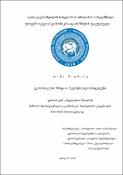Options
ეკონომიკური ზრდის რეგრესიული მოდელები
Date Issued
2020
Author(s)
Advisor(s)
Institution
Abstract
Presented paper discusses regressive models of economic growth, through this, the
quantitative impact of factors affecting economic growth is analyzed and estimated. The paper
is divided into theoretical and practical parts. The theoretical part discusses the main
approaches and models of regressive analyze, which is the learning basis of different aspects of
the economic growth in the modern conditions.
The practical part presents the analyze of the estimated economic growth models. Three
types of models are especially distinguished. The first one is economic growth panel model,
which was evaluated using the panel data about 10 countries of Europe and Central Asia during
1997-2018 years. The dependent variable of the model is the growth rate of GPD per capita, as
for independent variables, with dependent variable lag meaning, they represent calculated rates
of export, fixed capital formation and growth of consumer costs of government.
Second option of evaluated model is the part of autoregressive distributed lag model
(ARDL) group. Using 2003-2019 years’ economy quarterly data of Georgia, we evaluated real
GDP growth relationship with the factors such as, dependence variable lag meaning, direct
foreign investment growth, foreign trade, inflation, real exchange rate and real loan interest
rate.
Using the third, SARIMA model of economic growth, we evaluated the forecasting
function of GDP quarterly growth variables of Georgia. As for the forecasting function, we
discussed SARIMA(2,0,2)(1,1,0)4 model, which we calculated according to temporal row of
economic growth rate quarterly data during 1997-2019 years.
quantitative impact of factors affecting economic growth is analyzed and estimated. The paper
is divided into theoretical and practical parts. The theoretical part discusses the main
approaches and models of regressive analyze, which is the learning basis of different aspects of
the economic growth in the modern conditions.
The practical part presents the analyze of the estimated economic growth models. Three
types of models are especially distinguished. The first one is economic growth panel model,
which was evaluated using the panel data about 10 countries of Europe and Central Asia during
1997-2018 years. The dependent variable of the model is the growth rate of GPD per capita, as
for independent variables, with dependent variable lag meaning, they represent calculated rates
of export, fixed capital formation and growth of consumer costs of government.
Second option of evaluated model is the part of autoregressive distributed lag model
(ARDL) group. Using 2003-2019 years’ economy quarterly data of Georgia, we evaluated real
GDP growth relationship with the factors such as, dependence variable lag meaning, direct
foreign investment growth, foreign trade, inflation, real exchange rate and real loan interest
rate.
Using the third, SARIMA model of economic growth, we evaluated the forecasting
function of GDP quarterly growth variables of Georgia. As for the forecasting function, we
discussed SARIMA(2,0,2)(1,1,0)4 model, which we calculated according to temporal row of
economic growth rate quarterly data during 1997-2019 years.
Degree Name
MSc in Economics
Degree Discipline
ეკონომიკა / Economics
File(s)
Loading...
Name
Samagistro Maghradze.pdf
Description
ეკონომიკური ზრდის რეგრესიული მოდელები
Size
2.27 MB
Format
Adobe PDF
Checksum
(MD5):075dbf77ac45b653c69390717e301311